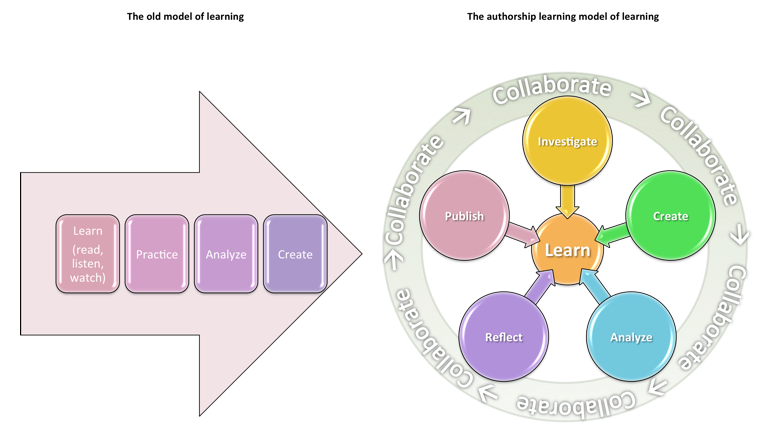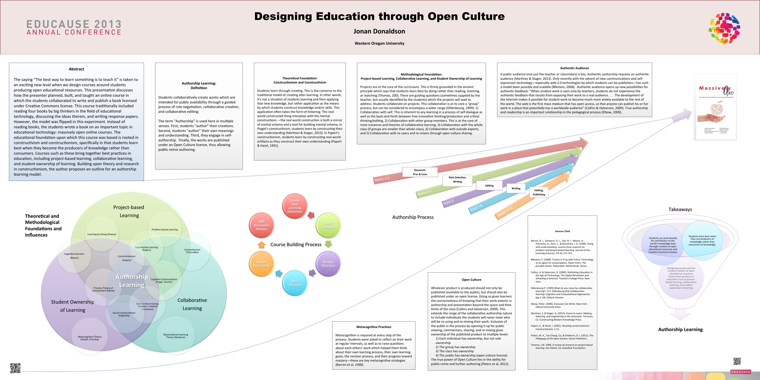Authorship Learning Goes Online and Open
Western Oregon University Instructional Design Specialist Jonan Donaldson is taking authorship learning to a new level. At EDUCAUSE’s 2013 conference, he presented on his experience with authorship learning and a recent project he was involved in. First, here’s an overview of authorship learning with some context provided by educators at Miami University (PDF download).
What Is Authorship Learning?
In short, it’s a way for educators to turn the tables on students, encouraging them to become educators of others and themselves.
Adolescents typically depend on authority figures to determine what to believe, how to view themselves, and how to act in relationships. The transition to adulthood comes with the expectation that individuals shift the source of their beliefs, identity, and social relations from the external world to the internal voice. Self-authorship — or the capacity to listen to, cultivate, and trust the internal voice to guide one’s life — represents the culmination of this shift.
The transformation from authority dependence to self-authorship requires questioning trusted authority and leaving the safety of comfortable ways of seeing the world to explore multiple perspectives and construct one’s own beliefs, values, and vision.
EdTech asked Donaldson to sum up authorship learning in his own words, and he offered to this succinct description:
We learn best by doing, the best doing is creating, and the best creating is for an authentic audience. To condense it even more, the most powerful learning happens when students create things to be shared with the public.

Clearly, there is merit to the approach, but how can educators implement authorship learning in the classroom?
“The best way to learn something is to teach.”
Donaldson, an experienced educator with a master’s degree in information technology, is a fan of authorship as well as open educational resources. He blended the two in a recent online course he taught.
This course traditionally included reading four books by big thinkers in the field of educational technology, discussing the ideas therein, and writing response papers. However, the model was flipped in this experiment. Instead of reading books, the students wrote a book on an important topic in educational technology: massively open online courses. The educational foundation upon which this course was based is rooted in constructivism and constructionism, specifically in that students learn best when they become the producers of knowledge rather than consumers.
The book was published under an Open Culture license and can also be purchased on Amazon. Here are a few more excerpts from his presentation, which you can see below.
Does “Authorship” Have Multiple Meanings?
The term “Authorship” is used here in multiple senses. First, students “author” their creations. Second, students “author” their own meanings and understanding. Third, they engage in self-authorship. Finally, the works are published under an Open Culture license, thus allowing public remix authoring.
How Is the Authorship Model Different?
Students learn through creating. This is the converse to the traditional model of creating after learning. In other words, it's not a situation of students learning and then applying that new knowledge, but rather application as the means by which students construct knowledge and/or skills. This application often takes the form of tinkering. The real-world constructed thing interplays with the mental constructions — the real world construction is both a mirror of mental schema and a tool for building mental schema.
What Is the Audience Effect?
A public audience (not just the teacher or classmates) is key. Authentic authorship requires an authentic audience (Martinez & Stager, 2013). Only recently with the advent of new communications and self-expression technology — especially web 2.0 technologies by which students can be publishers — has such a model been possible and scalable. Authentic audience opens up new possibilities for authentic feedback: “When student work is seen only by teachers, students do not experience the authentic feedback that results from exposing their work to a real audience. The development of the Internet makes it possible for student work to become much more widely available to the rest of the world.”
Take a look at this amazing infographic Donaldson used to present at EDUCAUSE 2013. Click to view a larger version.









